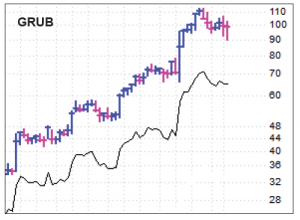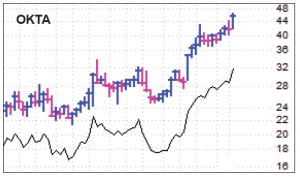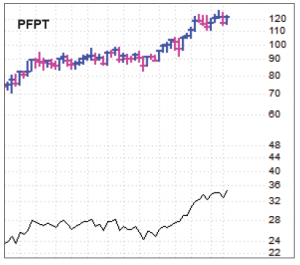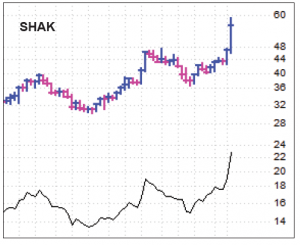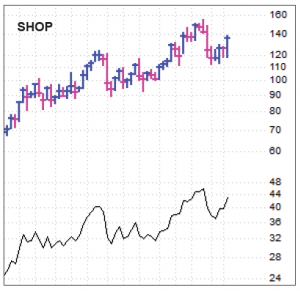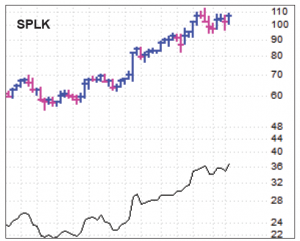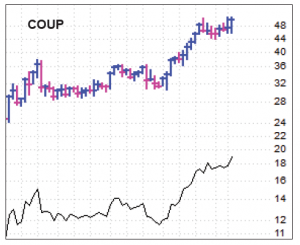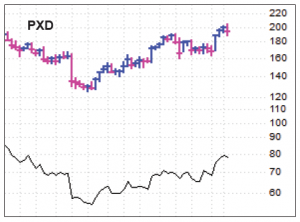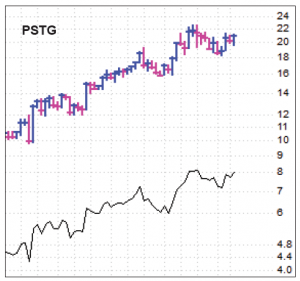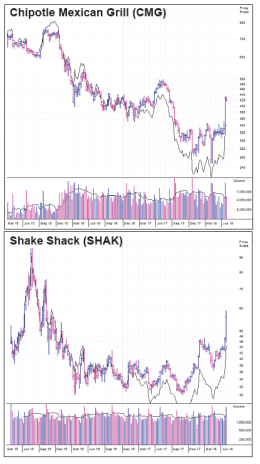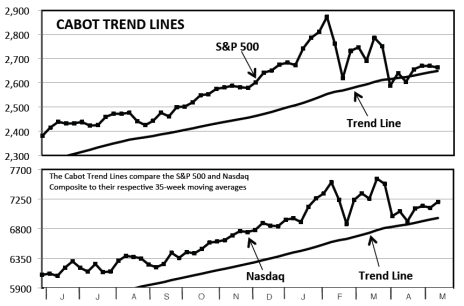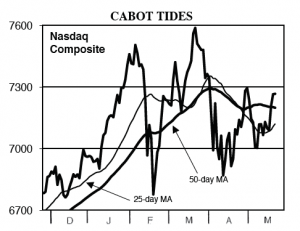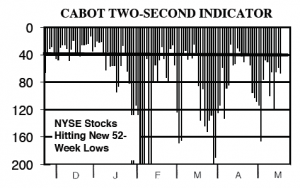During the past three-plus months, the market has put in a firm foundation, with numerous tests of long-term support, positive divergences among various breadth measures and three legs down to the correction. And now we’re starting to see buyers take control—today our Cabot Tides flashed a green light, telling us to begin putting money to work.
Cabot Growth Investor 1393
[premium_html_toc post_id="149836"]
Firm Foundation in Place
When you’re a student of the market, most of your focus isn’t on minute details like debt maturity schedules, gross margins and depreciation expenses, but instead on how the market actually works. And when it comes to market timing, one of the first things you learn is that corrections will often have three legs down.
Why three legs? Psychology—it takes both time and falling prices to move the sentiment pendulum from greed to worry. The first leg down is completely unexpected and produces almost no panic—everyone believes it’s just a normal pullback in a strong bull market. By the time the second leg down occurs, it’s been a few weeks since the market’s peak and some bad news has usually popped up; investors now realize a correction is unfolding, causing them to trim here and there.
The third leg wipes out most of the remaining resilient stocks and gets more and more investors talking about a bear market—oftentimes right before the market starts a new leg up.
This year’s market correction mostly followed the pattern, with the February meltdown the first leg, the March decline the second leg, and the choppy April pullback (which brought a bunch of gaps lower from potential leading growth stocks) the third. All told it’s been three-plus months of tedious downside action and multiple tests of long-term moving averages, with selling pressures lightening with every test (fewer stocks hitting new lows on every test of the correction lows).
Thus, by our eye, the correction that started in late January has been relatively normal and put in a firm foundation for a new advance. And now the buyers are starting to take control! Today, our Cabot Tides flashed a green light, telling us the market’s intermediate-term trend is beginning to turn up. (The longer-term Cabot Trend Lines have remained bullish throughout the downturn.)
Of course, that doesn’t mean it’s time to jump in with both feet; there are still plenty of potential banana peels for the market to slip up on, including lots of resistance on the way up for the major indexes. But we always go with the evidence, and with the Tides now positive, we’re putting some money to work.
[highlight_box]WHAT TO DO NOW: In the Model Portfolio, we sold our small position in Shopify (SHOP) and half our shares of Grubhub (GRUB) last week when the market was threatening to break down. But tonight, we’re adding two new stocks—Okta (OKTA) and Shake Shack (SHAK), leaving us with about 30% in cash.[/highlight_box]
Model Portfolio Update
The past couple of weeks were relatively tough for growth stocks, with the overall market sagging and a fair number of poor earnings reactions. In response, we did a little selling, raising our cash from around 45% to 51% by selling all of one stock (SHOP) and half of another (GRUB).
However, during the past few days, the market has come alive, enough for our Cabot Tides to flash a green light! Sure, there’s always the chance that this (or any) Buy signal could fail, but combining the multiple retests of the correction lows, the positive Tides and the attractive action of many growth stocks, it’s time to put some money to work.
As for our game plan, we’ll do the usual—start slow and build if the action of the market and leading stocks continues to improve. Tonight, we’re adding 10% positions in two new stocks, Okta (OKTA) and Shake Shack (SHAK), which still leaves us with a cash position of around 30%.
Current Recommendations
BUY—Five Below (FIVE 71)—When examining your stocks, it’s important to keep in mind their personalities. Some growth stocks are fiery and dynamic (on the upside and downside), while others, like Five Below (and many retailers) tend to be slower and steadier. Thus, FIVE’s recent action doesn’t appear abnormal to us—it hasn’t made any progress since the start of the year, but (a) neither has the S&P 500 and (b) the stock had a big run in the fourth quarter of last year. That doesn’t mean you should be complacent—it’s always possible the company’s expectations of a so-so middle of the year (partly due to tough comparisons, partly because of investments) could bring out the sellers. But with a profit cushion and having already taken partial profits, we’re using a looser stop (low 60s) because of the firm’s excellent longer-term growth potential. Long story short, if you own some, sit tight. And if you don’t, we think this dip to the 50-day line marks a solid entry point.
HOLD—Grubhub (GRUB 103)—We’ve seen a few shakeouts during this earnings season, where a stock gets nailed the day or two after its report, only to rally back soon after. That’s been playing out with Grubhub, which was whacked last week, supposedly on fears that some of the company’s sub-metrics in Q1 (like gross food sales) were a bit less than expected, causing us to dump half of our remaining position. But now shares have rallied back nicely, though they remain within their broader base-building effort of the past eight weeks. Short-term, GRUB could easily need more time to consolidate its prior run, but the recent strength is a good sign that big investors are willing to support the stock on dips. Fundamentally, we still expect years of massive growth as online food ordering and delivery services take off. (The firm’s strategic delivery deal with Groupon just went live in Chicago, and will go nationwide in the months ahead.) Analysts have bumped up their estimates since the Q1 report, seeing 47% earnings growth this year and another 27% next. If you still own a small position like us, sit tight.
BUY—Nutanix (NTNX 59)—One clue that you have a good stock on your hands is when you happen to buy it at nearly the exact wrong time (near a market peak or sub-peak), and yet the stock holds up and quickly gets back to new highs. That’s what we’ve seen so far with NTNX, which held its 50-day line during the recent leg lower and has snapped back to virgin turf this week. The company’s announcement last week that it was delaying its public cloud offering (which would compete with Microsoft Azure and Amazon Web Services), dented shares for a day or two, but the big idea here remains Nutanix’s leading position in hyperconverged infrastructure, which looks like the next big thing when it comes to corporate IT. In the near-term, shares will likely be yanked around by the market, but longer-term, we still believe NTNX can do very well during the next sustained market advance. We’ll stay on Buy. Earnings are due out May 24, so keep new positions on the small side.
BUY—Okta (OKTA 49)—Very few investors have heard of Okta, but it looks like a new leader in the cloud software space. The firm dubs itself the leading independent provider of identify solutions for the enterprise, which allows it to offer both productivity and security enhancements to big customers—fewer data breaches, easier collaboration among groups and partners, a better customer experience and easier integration of acquired firms and staffs are all benefits for Okta’s clients. Its cloud software suite has been a huge hit, with customers up 40% in the latest quarter (including a bunch of blue chips), the number of six-figure deals up 56% and with revenue rising 59%. (Earnings are still in the red but cash flow is approaching breakeven.) The stock broke out of a 10-month post-IPO base in February, went straight sideways during the market correction and has since surged to new highs. It’s a bit extended to the upside, but we’re putting more emphasis on OKTA’s strength and story. We’re buying it tonight, with an initial loss limit in the 41 to 42 area. Earnings are due out June 6.
HOLD—PayPal (PYPL 77)—PayPal was hit in the middle of last week after yet another round of competition fears, this one from Amazon, which will reportedly offer discounts to retailers to be part of its payment platform. We’ve written about the overblown fears of competition many times (the digital payments industry is enormous and growing, there’s room for a few players and PayPal is definitely one of the leaders with 237 million active accounts, including 19 million merchant accounts) and we think this is another case of that. Interestingly, we saw some massive call buying when PYPL dipped on the news (finding support at its 200-day line) and it’s been bouncing since. That said, we’re still handling our position in a fairly robotic way—if the stock closes below 71 or thereabouts, we’ll likely sell because the stock’s long-term uptrend would be in question. But above that level, we’re holding on and think PYPL can do very well once it finishes up its correction.
BUY—Proofpoint (PFPT 127)—Like Grubhub, PFPT took a sharp one-day hit on earnings despite topping estimates and raising its outlook, but has bounced back nicely since. (It’s also a plus to see its larger-cap peer, Palo Alto Networks, recently poke into new-high ground.) In its Q1 conference call, management wasn’t shy about listing a handful of huge customer wins—we counted 14 large new deals for a total of 750,000 users, which should bode well going forward, as Proofpoint’s renewal rate remains north of 90%. And management believes its cross-sell opportunities alone (it now has more than a dozen product offerings) are a $1 billion opportunity! Clearly, business is good, and management sees revenues, billings and cash flow continuing to grow at 30%-plus rates. The stock isn’t far from new high ground but this recent bounce has come on middling volume. If you own some, hang on.
BUY—Shake Shack (SHAK 58)—We’re always attracted to cookie-cutter stories, and Shake Shack has a big one, aiming to grow the number of restaurants in operation by more than 30% this year alone, and to more than double its company-operated restaurants by 2020. Of course, as a restaurant, there are usually more variables than a traditional retailer (food and labor costs), but those aren’t issues today and, besides, big investors are more focused on the growth potential. For more on SHAK’s story, see page 7. As for the stock, it’s exploded higher in recent weeks, including a giant earnings gap last week, but this comes after years of bottom-building, so we think the stock is early in a new advance. You can buy some around here, though we’ll be using a relatively loose initial loss limit in the upper 40s.
SOLD—Shopify (SHOP 146)—SHOP took an ugly hit last week following earnings, which, combined with its action of the past couple of months, led us to sell our small holding for a good profit. From today’s perspective, though, that appears to be a mistake, as SHOP has ramped higher during the past few days. Thus, we’ll be keeping an eye on it—a proper setup in the weeks ahead could lead to us getting back in. But, while the sell clearly wasn’t great, right now, SHOP is butting up against resistance and the rally’s been on so-so volume. If you still own some, by all means hang on. But we’re out of the stock and looking to fresher leaders once the market confirms a new uptrend.
BUY—Splunk (SPLK 115)—SPLK has come alive during the past two weeks, ramping to new highs above 113. Like most stocks, the move has come on sub-par volume, which is less than ideal, but given the market environment there’s no question the price action is encouraging. That said, the real test going forward will come on earnings, which are due out May 24; investors will be looking for any further tidbits on the accelerating pace of new client acquisitions and continued rapid revenue growth for the firm’s Big Data mining software. Right now, there’s no question that the overall evidence is positive, both fundamentally (Splunk’s software is becoming a leading player in the security sector) and technically (the steady, solid uptrend in place since the stock got going last November). If you own some, hold on, and if you don’t, we’re switching our rating back to Buy—though keep positions small given the upcoming quarterly report.
Watch List
Alibaba (BABA 195): A great Q1 report and yearly outlook helped the stock surge back toward its highs. The story is as big as ever, and we won’t hesitate to get back in if the longer-term uptrend resumes. See more below.
Axon Enterprises (AAXN 55): AAXN remains strong, soaring on earnings today after Q1 results last night easily blew away expectations. Better yet, a recently announced acquisition dramatically expands its geographic opportunities. A pullback or area of tightness could provide a nice entry point.
Continental Resources (CLR 68) or WPX Energy (WPX 19): Energy stocks are being pushed and pulled by oil prices (which are being pushed and pulled by some international tensions), but most look early stage and are acting well, with CLR, WPX and others looking good.
Etsy (ETSY 30): ETSY took a bit of a hit today on earnings, but the chart remains in fine shape. Fundamentally, Q1 again showed accelerating revenue and gross merchandise sales growth.
Spotify (SPOT 150): Spotify got clipped on earnings, which, short-term, isn’t ideal. But longer-term it could be a good thing, giving this new stock a chance to get its sea legs. Nothing in the quarterly report changed our view that SPOT’s opportunity is very big.
Other Stocks of Interest
The stocks below may not be followed in Cabot Growth Investor on a regular basis. They’re intended to present you with ideas for additional investment beyond the Model Portfolio. For our current ratings on these stocks, see Updates on Other Stocks of Interest on the subscriber website or email mike@cabotwealth.com.
Alibaba (BABA 195)—We were knocked out of BABA in March of this year when the stock broke support, and it eventually sank below its 200-day line and lived there for nearly a full month, raising the odds of a major top. But, now, that move is looking more and more like a shakeout, as buyers have emerged following a great Q1 report (sales up 76%, earnings up 44%). Management sees fiscal 2019 (which just started in April) revenue growth of 60%, and while the firm’s wave of new investments is likely to crimp earnings growth a bit (cash flow is expected to rise 33% or so this year, with earnings up 30%), big investors are putting more emphasis on Alibaba’s land grab in the e-commerce, cloud computing (revenues up 102% in the recent quarter) and digital media industries, thinking that earnings growth will eventually soar at even faster rates. Net-net, the stock went nowhere from September through April, eight months of chopping around, but has shown excellent buying volume in recent days as it races toward its highs. It’s back on our Watch List as the long-awaited next leg up could be starting soon.
Coupa Software (COUP 54)—Coupa is one of many cloud software stocks that have held up well during the market correction and, recently, are beginning to percolate. The company is the leading cloud platform for business spend management, offering clients a single solution to better track and manage procurement, contracts, invoices, expenses, sourcing, inventory and more. It’s a gigantic market and Coupa has inked a ton of big customers; all told, the firm’s platform processed $267 billion of spending during the past year (more than double the figure a year ago), with revenues growing at 35%-plus rates and earnings near breakeven. Encouragingly, management sees it as a natural fit in the back office ecosystem along with big boys Salesforce, ServiceNow and Workday. The stock is a bit thinly traded, but after a run to new highs in March, COUP moved mostly sideways through April and, now that the market has improved, has lifted to new highs.
Pioneer Natural Resources (PXD 202)—Every week that goes by we grow increasingly optimistic that energy stocks—which had a bear market in 2015 and early 2016 and, after a multi-month bounce, did mostly nothing in 2017—are beginning a sustained run higher. Pioneer looks like a leading big-cap play in the group ($34 billion market cap) that, thanks to a few divestitures, is almost solely focused on the Permian Basin. Management believes it has a mind-boggling 20,000 potential wells to drill, or about 75 times the firm’s planned drilling program this year. Q1 results were terrific (sales up 65%, and earnings up six-fold off a low base), and Pioneer expects 21% production growth this year and has a long-term plan of around 20% output growth annually through 2026! Who knows if that forecast comes true, but there’s no question the wind is at the company’s back today. The stock, which built a base from January through April, is now nosing out to multi-year highs.
Pure Storage (PSTG 23)—Demand for data storage is always increasing, but the industry is in the midst of a massive shift—out are the outdated disk-based systems, and in are flash- and cloud-based storage solutions that offer simplicity, lower downtime, higher performance and, most important, dramatically lower costs. Pure Storage is one of the leaders in this new field of storage, with some of the most efficient flash-based systems, and the results reflect that: Revenues have grown 38%, 41% and 48% over the past three quarters, free cash flow is positive and analysts see the rapid growth continuing in the quarters ahead. The stock has nosed out to new highs from a 10-week base and earnings, which are due out May 21, could provide a catalyst. If all goes well, Pure could follow in the footsteps of big winning storage plays like EMC and NetApp.
Two More Enticing “Reality” Plays
A couple of months ago, we wrote about the “Romance-Transition-Reality” scenario that’s playing out with cybersecurity stocks, with one emerging blue chip (Palo Alto Networks) and one mid-cap outfit (Proofpoint) leading the way. Despite a tough market environment since then, both stocks have held up well, and we’re optimistic both can do very well when the bulls retake control.
While it’s not as strong an industry move, we’re seeing two similar situations playing out in the restaurant sector. The industry itself isn’t necessarily inspiring (restaurants can get pushed and pulled by labor and food costs and are dominated by older, slow-growing firms), but we see a couple of “Reality” plays that have great potential going forward.
The first, like Palo Alto Networks, was a big leader a few years ago, went through the wringer and is now back on the upswing. Chipotle Mexican Grill (CMG) had an unmatched record of growth through 2015 (earnings grew more than six-fold from 2008 through 2015!), but some overexpansion, poor cost controls and, more than anything, a string of contamination issues, crimped business. Earnings collapsed 90% in 2016, sales slipped 13% and the stock eventually fell about two-thirds from its peak.
Now, though, a turnaround looks to be in effect, with earnings and (to a lesser extent) sales perking up, costs and quality seemingly under control and with management continuing its store expansion plan (the store count should rise just under 6% this year). Analysts see earnings rising 30% this year and another 34% next year, and the stock’s reaction to Q1 earnings was terrific. CMG is worth watching.
A more dynamic growth story comes from Shake Shack (SHAK), which bills itself as a modern roadside burger joint, with premium burgers, dogs, fries and shakes. Customer loyalty seems very high (it’s got a bit of a cult-like feel to it, in a good way), but competition and higher costs (food and labor, but also store opening expenses) have crimped earnings, which kept the stock under wraps following a post-IPO plunge in 2015.
However, the potential here remains huge—revenue growth has remained excellent for many quarters, and while same-store sales have lagged, they’re starting to perk up (up 1.7% in Q1). Most of all, Shake Shack has a very aggressive and impressive expansion plan—the firm had 159 restaurants in operation at the end of last year, but anticipates 50 new ones this year alone! And management believes it can have 200 company-operated restaurants by 2020 (up from 90 today; the rest are licensed)!
Because of that, analysts see revenues up between 25% and 30% during the next couple of years, with earnings growth finally kicking into gear in 2019. But that might be too conservative—Q1 earnings easily topped expectations and lifted 44%, causing the stock to go bananas, ripping to multi-year highs on 8 times average volume.
We’re very intrigued by Shake Shack’s growth potential and the stock’s action. We are adding it to the Model Portfolio tonight.
What Matters Are the Outliers
If you’re like most investors, you’ve probably been chewed up a bit during the past three months as the market has corrected. Some stocks you own have been dented. Others you sold only to see them bounce back. And some that you held stagnated and got hit on earnings. And so on.
This type of grinding action often can be a bummer, but you shouldn’t let it get you down. Remember that, over time, it’s really the outliers—your big winners and big losers—that drive performance. In our experience, most of your trades (small winners, small losers, breakeven-ish trades) tend to cancel each other out, while the outliers make the difference.
That doesn’t mean you shouldn’t try to do better; we’re big fans of doing some post-op of every trade to come up with some more dos and don’ts. But don’t obsess over getting chopped around a bit—it’s part of the ballgame, and, if this rally is the real McCoy, will be quickly made up by strong performers.
Cabot Market Timing Indicators
The market looked ready to cave in late last week, but support held and, all of a sudden, the buyers have shown up! Our Cabot Tides flipped to positive today, and while there are still obstacles to overcome, there’s enough bullish evidence to do some new buying.
Cabot Trend Lines: Bullish
It’s been a choppy, tedious three months, but throughout it our Cabot Trend Lines have remained positive, giving us conviction that the bull market remains in effect. At the end of last week, the S&P 500 (by 0.5%) and Nasdaq (by 3.5%) were both above their respective 35-week lines, telling us that the longer-term trend continues to point up.
Cabot Tides: Bullish
Our Cabot Tides flipped to positive today, as three of the five indexes we track (led by the Nasdaq Composite, the daily chart of which is shown here) are now clearly above their lower (usually 25-day) moving average, and that moving average is advancing. Granted, not every index is in gear (the NYSE Composite, for instance, has yet to turn up), and there’s still resistance to chew through on the way up. But, overall, the intermediate-term trend is turning up—reason enough to start putting some money back to work.
Two-Second Indicator: Unhealthy
The Two-Second Indicator has flashed numerous positive divergences in recent weeks, as every time the major indexes slip toward their February lows, the number of new lows continues to decline (479 in February, 215 late March, 166 in late April and 121 last Thursday). That’s a big plus—but we still need to see the number of new lows dry up to fewer than 40 on a consistent basis before concluding that the broad market is truly healthy.
[premium_html_footer]
Send questions or comments to mike@cabotwealth.com.
Cabot Growth Investor • 176 North Street, Post Office Box 2049, Salem, MA 01970 • www.cabotwealth.com
All Cabot Growth Investor’s buy and sell recommendations are made in issues or updates and posted on the Cabot subscribers’ website. Sell recommendations may also be sent to subscribers as special bulletins via email and the recorded telephone hotline. To calculate the performance of the portfolio, Cabot “buys” and “sells” at the midpoint of the high and low prices of the stock on the day following the recommendation. Cabot’s policy is to sell any stock that shows a loss of 20% in a bull market (15% in a bear market) from our original buy price, calculated using the current closing (not intra-day) price. Subscribers should apply loss limits based on their own personal purchase prices.
Charts show both the stock’s recent trading history and its relative performance (RP) line, which shows you how the stock is performing relative to the S&P 500, a broad-based index. In the ideal case, the stock and its RP line advance in unison. Both tools are key in determining whether to hold or sell.
THE NEXT CABOT GROWTH INVESTOR WILL BE PUBLISHED MAY 23, 2018
We appreciate your feedback on this issue. Follow the link below to complete our subscriber satisfaction survey: Go to: www.surveymonkey.com/marketlettersurvey
Neither Cabot Wealth Network nor our employees are compensated by the companies we recommend. Sources of information are believed to be reliable, but are in no way guaranteed to be complete or without error. Recommendations, opinions or suggestions are given with the understanding that subscribers acting on the information assume all risks. © Cabot Wealth Network. Copying and/or electronic transmission of this report is a violation of U.S. copyright law. For the protection of our subscribers, if copyright laws are violated, the subscription will be terminated. To subscribe or for information on our privacy policy, call 978-745-5532, visit www.cabotwealth.com or write to support@cabotwealth.com.
[/premium_html_footer]




